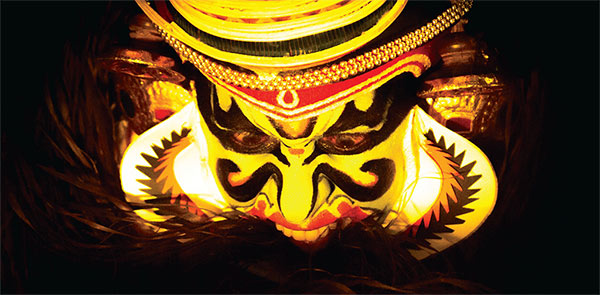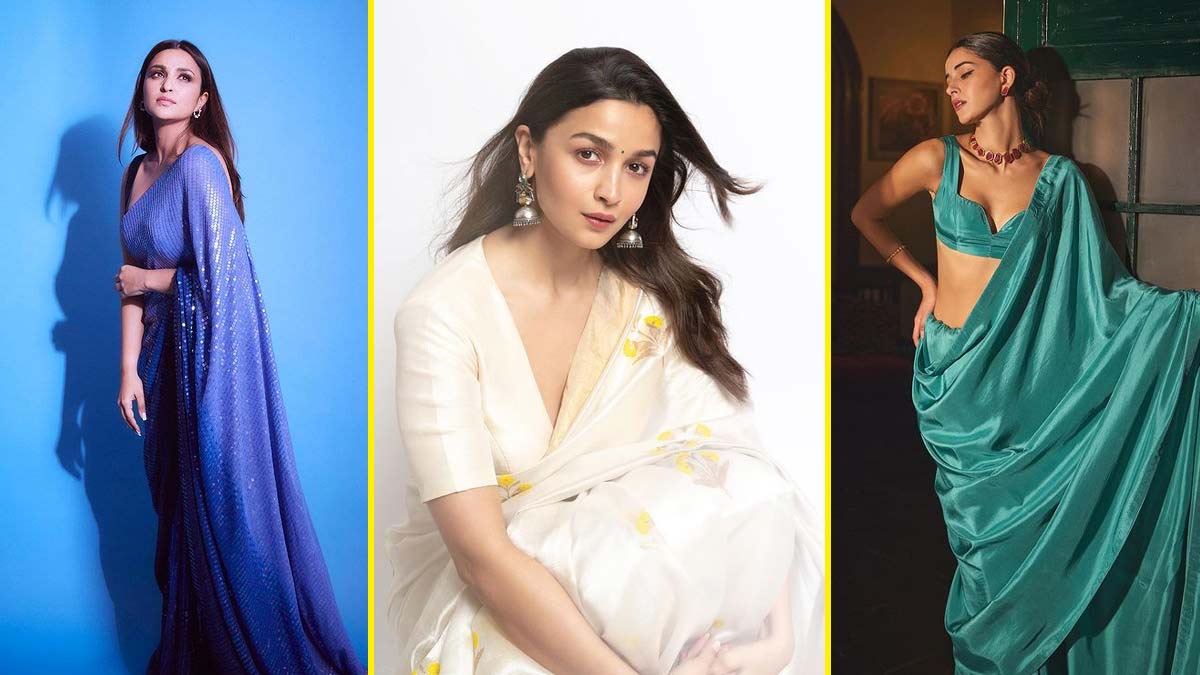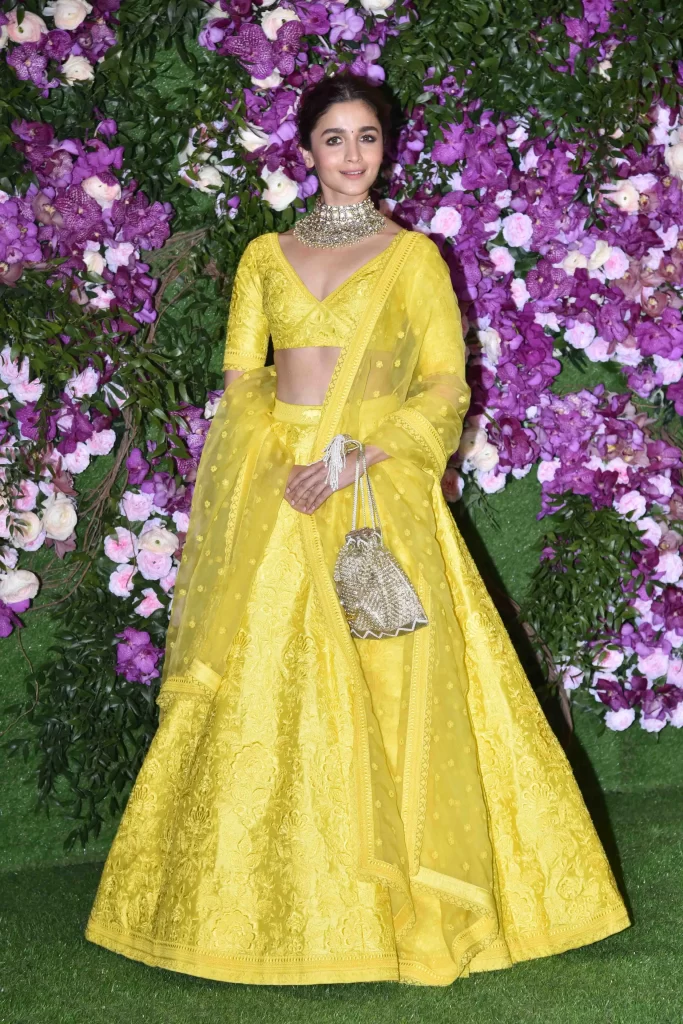Art
An All Women Kathakali Saga
FWD life gets in touch with the world’s first and one of its kind all women’s Kathakali troupe.

Strolling through the veranda, I was led to the Tripunithura Temple Ootupura. The chimes of pancharimelam rang in my ears. As I walked into the green room, I could hear those feminine laughs and titters. I saw a few many women getting ready for their enactment of Duryodhanavadham. If an experience could be a transformation then what I witnessed sufficed. There they sat patiently, as their faces slowly got masked. Ironically it was to reveal another story. The lashes flickered in intensity, I could sense the excitement. They were getting ready for their role reversals. From the initial makeup to the final positioning of Kireedam(crown), I was lucky enough to capture all these moments with my eyes and write stories in my mind
Grandeur Of Kathakali
It is true to say that Kathakali, a highly complex and stylized temple art form is where Gods and Demons come to play. Probably the only art form where the audience can see the emotions ascend and reach its impeccable best. For instance, in the Duryodhanavadham, one gets to see a vengeful Bhima dancing in fury clashing with Dushasana on the battlefield. The pinnacle of the play is the convergence of conflicted emotions. Bhima dances his hunger for avenge; Dushasana his defiance. The fighting takes the form of a duet with clattering drums and crashing cymbals that are overwhelmingly energetic. Hands interlinked, the combatants spree on the stage each propelling the other into a new level of spleen. Good triumphs over Evil, as the proverb inevitably goes. Bhima knocks down Dushasana onto the ground with his mace. An out of control Bhima rips out his foe’s entrails and drinks his blood. In utter oblivion of what is going on, Bhima reaches a point of vengeful ecstasy. As Lord Krishna enters, he begins to return to his senses; realising what he has done, Bhima falls on his face in front of Lord Krishna and begs for pardon. As he receives the lord’s benediction, Bhima’s mannerisms completely change. One can see the anger drain from his body to be replaced by the tender mood of poignancy, and this is the moment when the audience gets to experience trance. It is probably at these moments when people talk about the divine manifestation through human bodies; Kathakali fulfills that.
Skimming Through The History
For more than three centuries, Kathakali, belonged to the upper-class men. Later when the caste system was officially abolished, boys from all the backgrounds were permitted to get themselves trained and perform. It was in 1975, which was coincidentally the International Year of Women, when a group of immensely talented young women formed an all women-troupe. It was a period when youth festivals were gaining momentum among the students, and there was a section for Kathakali. During one such lot, few girls performed, beat the boys and won the prize. And few judges quipped, “Had we knew that they were girls, we wouldn’t have given them the prize.” Padmasri Kalamandalam Krishnan Nair, the doyen of Kathakali, was then residing in Tripunithura. He took the initiative to give solo performances with girls in it. He called Radhika Varma, Shylaja Varma and few others who perform Kathakali, two women from Palakkad who sing, a woman from Kollam who plays the chenda and formed a group. That’s how the world’s first all-women Kathakali troupe took its first breath – The Tripunithura Kathakali Kendram Ladies Troupe.
Although the troupe had made their presence felt in the field of Kathakali, it was only in 1999, that Kalamandalam recognized this troupe and invited them to perform. “Earlier, people came to watch our performance, not because they felt we were good; because they were curious. Let us see what these girls can do! So was their attitude,” says Geetha Varma, one of the senior most members of the troupe.
The Story
It was in the year 2002 that the troupe made its international debut. Three months and 19 shows. During one of these shows, Radhika Varma, the first woman of the troupe did a demonstration about 9/11 at Washington. “When asked the audience whether they understood anything, what we received was utter silence. We heard whispers and then the audience started shouting ‘It is 9/11!’.” quipped Radhika Varma.
The demonstration culminated with a thumping applause. The misconception of Kathakali not being understood by common men stood as a contradiction to this event. Being a woman is not easy. Being a woman artist is all the more difficult. One of the major drawbacks of the troupes now is that there are no female chenda artists. The troupe mourns the fact that many talented women who were part of the group before marriage had to leave soon after their wedding. When asked about the changing audience for Kathakali over the years, Parvathy Menon, also a senior artist in the troupe said, “the number of youngsters who come to watch Kathakali has definitely gone over the years. But for the performance which lasts through the night, which also is very rare now, we find very little audience.”When asked about what the biggest achievement of the troupe is, Geetha Varma says, “We started performing when we were not even allowed to think of performing. We started from there. It has been nearly 30 years since we have been performing. We have done about 1500 performances. The biggest achievement that we feel proud about is that today girls and young women are coming up and performing with male artists. We could probably say that we are a reason for this.”
I realize that walking into a man’s world might be difficult but is certainly not impossible. The group stands as strong pillars, not just reflecting the past, but as living examples who’d inspire the generations to come
Photos: Ramesh Varma and Aabha Muralidharan
Art
Navratri 2024: Celebrating the Nine Colours and Their Significance

Navratri, the festival that spans nine nights, is one of the most auspicious and widely celebrated festivals in India. Dedicated to the worship of Goddess Durga in her nine forms, each day of Navratri holds special significance, marked by a distinct color that carries deep spiritual and cultural meaning. As we prepare for Navratri 2024, let’s explore the nine colors associated with each day, their significance, and how they inspire devotion, positivity, and harmony.
Day 1: Yellow

On Thursday, embrace the uplifting energy of yellow as you celebrate Navratri with optimism and joy. This warm and cheerful color symbolizes happiness and radiates positivity, keeping you in high spirits throughout the day.
Day 2: Green

On Friday, wear green, a color that represents nature, growth, and harmony. It evokes a sense of peace and serenity, while also symbolizing new beginnings. Let the vibrant energy of green invite tranquility and the blessings of the Goddess into your life.
Day 3: Grey

Saturday calls for the subtle sophistication of grey. This balanced color keeps you grounded and calm, symbolizing composure and understated elegance. It’s perfect for those who want to participate in Navratri with grace while making a refined style statement.
Day 4: Orange

On Sunday, adorn yourself in the vibrant hue of orange. This color embodies warmth, exuberance, and positivity. Wearing orange during Navratri invokes an upbeat energy, bringing vitality and a lively spirit to your celebrations.
Day 5: White

Start your Monday with the purity and serenity of white. Associated with innocence and spiritual clarity, this color invites inner peace and helps you connect with the divine blessings of the Goddess, offering a sense of security and calm.
Day 6: Red

On Tuesday, red takes center stage, symbolizing passion, love, and strength. As one of the most auspicious colors, red is often offered to the Goddess in the form of a Chunri. Wearing red fills you with energy, vigor, and the vibrant spirit of Navratri.
Day 7: Royal Blue

Wednesday’s color is royal blue, representing elegance, richness, and tranquility. This deep, vivid shade of blue exudes confidence and sophistication, making it an ideal choice for those who want to celebrate Navratri with style and grace.
Day 8: Pink

On Thursday, don the charming hue of pink, a symbol of universal love, affection, and harmony. Pink is a color that adds a soft touch of warmth and approachability, making it perfect for creating a loving and joyful atmosphere during the festivities.
Day 9: Purple

On the final day of Navratri, purple takes the spotlight. Associated with luxury, nobility, and grandeur, purple invites opulence into your life. Wearing this regal color while worshipping Navdurga bestows blessings of prosperity and richness, making it the perfect way to end your Navratri celebrations.
Art
Exploring the Rich Tapestry of Indian Art: A Journey Through State-Wise Traditional Paintings

India’s artistic heritage is a vibrant mosaic, reflecting the diverse cultural traditions of its states. Each region has its unique style of painting, with techniques and themes passed down through generations. Let’s delve into some of the most iconic traditional paintings from different states of India.
1. Madhubani Painting (Bihar)

Originating from the Mithila region of Bihar, Madhubani painting is known for its intricate patterns, bold colors, and themes inspired by nature, mythology, and folk tales. Traditionally, these paintings were done on mud walls, but now they are also created on cloth, handmade paper, and canvas.
Distinctive Features: Use of natural dyes, double outlines, geometrical patterns, and motifs like flowers, animals, and deities.
2. Pattachitra (Odisha and West Bengal)

umaid art
Pattachitra, meaning ‘cloth painting,’ is an ancient art form from Odisha and West Bengal. These paintings depict mythological narratives, especially around Lord Jagannath, and are characterized by their intricate details and mythological themes.
Distinctive Features: Fine detailing, elaborate borders, vibrant use of colors, and the use of natural ingredients for dyes.
3. Warli Art (Maharashtra)
Warli art is a form of tribal painting from Maharashtra, traditionally done by the Warli tribe. It primarily uses white pigment on a mud base to depict daily activities, such as farming, hunting, and dancing, in a minimalistic yet expressive manner.
Distinctive Features: Simple geometric shapes like circles, triangles, and squares, which represent different elements of nature and human life.
4. Tanjore Painting (Tamil Nadu)

Tanjore (or Thanjavur) paintings, originating from Tamil Nadu, are known for their rich colors, surface richness, compact composition, and use of gold foil. They often depict Hindu gods and goddesses, with a focus on Lord Krishna and other deities.
Distinctive Features: Use of vibrant colors, gold leaf, and inlay work with semi-precious stones on wooden boards.
5. Pichwai Painting (Rajasthan)

Pichwai paintings, hailing from Rajasthan, are intricate paintings that portray the life of Lord Krishna, especially in the Nathdwara temple. These paintings are traditionally done on cloth and used as wall hangings behind the deity in temples.
Distinctive Features: Detailed depiction of Lord Krishna’s life, use of bright colors, and the portrayal of various scenes from the Bhagavad Purana.
6. Phad Painting (Rajasthan)
Phad painting is a narrative scroll painting from Rajasthan, where the stories of folk deities like Pabuji and Devnarayan are depicted. The paintings are done on long pieces of cloth and are used in religious storytelling.
Distinctive Features: Bold lines, earthy colors, and the depiction of deities and their exploits.
7. Kalamkari (Andhra Pradesh)

Kalamkari, literally meaning ‘pen work,’ is an art form from Andhra Pradesh that involves hand-painting or block printing on fabric. The themes are largely mythological, with stories from the Ramayana and Mahabharata being common subjects.
Distinctive Features: Intricate handwork, natural dyes, and a distinctive color palette dominated by earthy tones.
8. Pithora Painting (Gujarat and Madhya Pradesh)

Pithora paintings, created by the Rathwa and Bhilala tribes of Gujarat and Madhya Pradesh, are done on the walls of their houses. These paintings are part of a ritual to invite the gods and ensure prosperity and happiness.
Distinctive Features: Vibrant colors, ritualistic significance, and the depiction of gods, animals, and scenes from daily life.
9. Chitrakathi Painting (Maharashtra)

Chitrakathi is a traditional art form from the Maharashtra-Karnataka border, where paintings are used as visual aids in storytelling. These paintings often accompany performances that narrate stories from epics like the Ramayana and Mahabharata.
Distinctive Features: Simple yet expressive figures, use of natural colors, and the narrative style.
10. Saura Art (Odisha)

Saura art is a form of mural painting by the Saura tribe of Odisha. It is similar to Warli art but has its unique elements, depicting the tribe’s daily activities, rituals, and deities.
Distinctive Features: Monochrome palette, linear style, and the depiction of nature and community life.
The diverse painting styles of India offer a glimpse into the country’s rich cultural heritage. Each state’s art form is a testament to the creativity and traditions that have been nurtured for centuries. By exploring these traditional paintings, we not only appreciate their beauty but also connect with the stories and values that have shaped India’s cultural landscape.
Art
The Microscopic Handbag Phenomenon: MSCHF’s Bold and Tiny Louis Vuitton Creation

In the realm of fashion, innovation knows no bounds, and the boundary-pushing collective known as MSCHF constantly proves this point. Their latest creation, a microscopic handbag inspired by Louis Vuitton, has taken the industry by storm, captivating fashion enthusiasts around the globe. Breaking free from traditional size constraints and redefining functionality, this miniature accessory has ignited curiosity and sparked a sensation. Join us as we delve into the extraordinary world of MSCHF’s microscopic handbag, exploring its origins, unique features, and the remarkable buzz it has generated.
MSCHF, renowned for their unconventional and thought-provoking projects, partnered with luxury fashion house Louis Vuitton to unleash a game-changing collaboration. Together, they birthed a surprising twist on the classic handbag, pushing the boundaries of scale to an entirely new level. The microscopic handbag challenges the norm and introduces an audacious new concept.

Measuring a mere 1.5 inches in height, the microscopic handbag is a masterpiece of miniaturization. This whimsical accessory captures the essence of a traditional Louis Vuitton purse, complete with the iconic monogram pattern and signature leather trim. Despite its minuscule size, it exudes luxury and craftsmanship, embodying the brand’s prestige and aesthetic.
The MSCHF microscopic handbag represents a captivating fusion of fashion and art. It blurs the lines between these creative realms and prompts us to question our perception of material possessions. Through this micro-sized wonder, MSCHF challenges our understanding of fashion’s role in society and invites us to contemplate the value we attach to material goods.
Since its introduction, the microscopic handbag has caused a viral sensation across social media platforms. Its diminutive size and unexpected collaboration have captivated fashion enthusiasts and sparked intriguing discussions. This extraordinary creation serves as a catalyst for conversations about fashion trends, the power of satire in design, and the evolving landscape of the industry. Once again, MSCHF has successfully captured the attention of the fashion world, pushing boundaries and reshaping our perception of what is considered fashionable.
MSCHF has cemented its legacy as a disruptive force in the fashion and art realms. Their innovative and thought-provoking projects consistently challenge norms and captivate audiences. With the microscopic handbag, they have once again showcased their ability to generate intrigue, spark conversations, and inspire wonder within the industry.
In conclusion, the MSCHF microscopic handbag stands as a testament to bold creativity and audacity in the world of fashion. Its tiny size and unexpected collaboration with Louis Vuitton have shattered conventional handbag design and ignited curiosity on a global scale. This extraordinary creation not only exemplifies the artistry and innovation of MSCHF but also invites us to reflect on the ever-evolving nature of fashion and its profound impact on our collective imagination. As we eagerly anticipate MSCHF’s next groundbreaking venture, one thing is certain: they will continue to redefine the boundaries of what is possible in the world of fashion.
-

 Style11 months ago
Style11 months agoBridal Guide : Best Looks of Radhika Merchant Ambani
-

 Fashion1 year ago
Fashion1 year agoMost Discussed Ajrakh Saree of Alia Bhatt
-

 Entertainment1 year ago
Entertainment1 year agoThe Most Stylish Guests of Bhagya Suresh Reception
-

 Entertainment1 year ago
Entertainment1 year agoBridal Bliss : All Bridal Looks of Swasika Vijay
-

 Movies1 year ago
Movies1 year agoA Nostalgic Journey Through Love &Cinema : Best Bollywood Romantic 90s Movies
-

 AD8 months ago
AD8 months agoPopular Curtain Fabrics to Consider for Your Home
-

 Fashion1 year ago
Fashion1 year agoMajor Denim Trends You Need To Know in 2024
-

 Events9 months ago
Events9 months agoBest of Fashion Looks : Diya Krishna Wedding





























